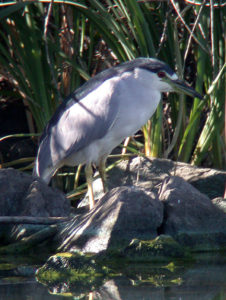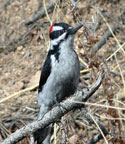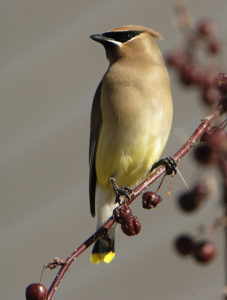Well, it was another beautiful morning at Hudson Gardens! What a great place to stroll around and look at birds! Starting with the waterfowl, we had many Mallards – females with their attendant youngsters, and males in various stages of acquiring eclipse plumage. I know that all of you who have come on our Front Range Birding Company walks now know that eclipse plumage is when male ducks, towards the end of breeding season, molt from their brilliant breeding plumage to a dull, cryptic plumage. Furthermore, I’m sure you recall that this all happens at the same time that the main flight feathers are molting, and that some ducks actually become flightless for a few weeks – a good plan if you are temporarily flightless, to be more cryptically colored. With the next molt the brilliant male colors will return.
Getting good looks at three species of herons was a plus: Great Blue Heron, Snowy Egret, and Black-crowned Night-Heron. Just a reminder that Snowy Egrets have black legs with “golden slippers,” and they have a mostly black bill; Great Egrets, which we also get in Colorado, though not as commonly, have black legs and feet, and they have a yellow bill. Black-crowned Night-Herons get their name because they forage predominantly at night (and, yes, they have a black crown), and we were fortunate to see a couple of adults.
Then, we had three species of woodpeckers, including a recently fledged Downy Woodpecker – kind of fuzzy looking, short tail not grown out completely yet, and acting a bit doofy. And, we had a single adult male Hairy Woodpecker, the Downy’s larger cousin. About 97% of Hairy’s nest in the mountains, so seeing one in town during breeding season is a bit of an anomalie – not completely unexpected, but certainly unusual. We were fortunate to have both a Downy and the Hairy in the same binocular field of view, so it was handy to be able to compare these very similar looking species.
One funny occurrence of the morning was that as we were looking at a singing Northern Mockingbird (a song that had been confusing me for a few minutes), we also got to hear at the same moment the cat-like meow of the Gray Catbird. Both of the species are in the family Mimidae, along with several Thrashers. These birds are well known for the diversity of their songs, their capacity for song mimicry, and the incredible duration of their songs – sometimes over ten minutes.
Perhaps the stars of the morning were the numerous foraging adult Cedar Waxwings that were incredibly cooperative, to the extent that while being photographed one individual flew within two feet of the photographer. She didn’t have to work hard to get close to that bird!
‘Tis the season of baby birds, so in your backyards you should be seeing the adults feeding and tending to their young. Also, the Rufous and Calliope Hummingbirds which have already finished breeding to the northwest of us, are back in the area as their first step towards their migration southward.
Good birding!
Chuck Aid
Hudson Gardens, Jun 30, 2018
33 species
Mallard 34
Green-winged Teal 1
Double-crested Cormorant 13
Great Blue Heron 2
Snowy Egret 3
Black-crowned Night-Heron 2
Red-tailed Hawk 1
Rock Pigeon (Feral Pigeon) 4
Eurasian Collared-Dove 1
Mourning Dove 15
Downy Woodpecker 4
Hairy Woodpecker 1
Northern Flicker 2
Western Kingbird 3
Black-billed Magpie 1
Barn Swallow 3
Cliff Swallow 8
Black-capped Chickadee 4
House Wren 7
American Robin 12
Gray Catbird 1
Northern Mockingbird 1
European Starling 1
Cedar Waxwing 11
Yellow Warbler 14
Song Sparrow 2
Bullock’s Oriole 2
Red-winged Blackbird 7
Brown-headed Cowbird 5
Common Grackle 4
House Finch 19
American Goldfinch 1
House Sparrow 1








Comments
Write Comment